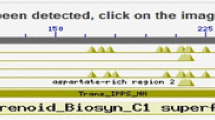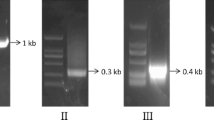Abstract
Shampoo ginger (Zingiber zerumbet Smith) has a high content and large variety of terpenoids in the essential oil of its rhizome. Here, we report on the isolation of a cDNA clone (ZSS1) encoding α-humulene synthase, a possible key enzyme of zerumbone biosynthesis. This clone contains an open reading frame of 1,644 bp and is predicted to encode a protein of 548 amino acids with a calculated molecular mass of 64.5 kDa. The deduced amino acid sequence shows 34–63% identity with known sesquiterpene synthases of other angiosperm species. Based on exon-intron organization, ZSS1 is classified as the terpene synthase-III (TPS-III) subfamily. When expressed in Escherichia coli, the recombinant enzyme catalyzed the formation of a major product, α-humulene (95%) and a minor by-product, β-caryophyllene (5%). Introduction of ZSS1 and the foreign mevalonate pathway involved in FPP synthesis into E. coli results in in vivo production of α-humulene. Transcript of ZSS1 was detected almost exclusively in rhizomes and was up-regulated in both leaves and rhizomes after treatment with methyl jasmonate (MeJA), suggesting its ecological function in shampoo ginger.





Similar content being viewed by others
Abbreviations
- DMAPP:
-
Dimethylallyl diphosphate
- DXP:
-
Deoxyxylulose 5-phosphate
- FPP:
-
Farnesyl diphosphate
- GC-MS:
-
Gas chromatography-mass spectrometry
- HMGS:
-
Hydroxymethylglutaryl CoA synthase
- HMGR:
-
Hydroxymethylglutaryl CoA reductase
- IPP:
-
Isopentenyl diphosphate
- IPPI:
-
Isopentenyl diphosphate isomerase
- MK:
-
Mevalonate kinase
- MeJA:
-
Methyl jasmonate
- MPD:
-
Mevalonate diphosphate decarboxylase
- ORF:
-
Open reading frame
- PMK:
-
Phosphomevalonate kinase
- RACE:
-
Rapid Amplification of cDNA Ends
- RT-PCR:
-
Reverse transcription PCR
- TPS:
-
Terpene synthase
References
Aharoni A, Giri AP, Deuerlein S, Griepink F, de Kogel WJ, Verstappen FW, Verhoeven HA, Jongsma MA, Schwab W, Bouwmeester HJ (2003) Terpenoid metabolism in wild-type and transgenic Arabidopsis plants. Plant Cell 15:2866–2884
Bohlmann J, Meyer-Gauen G, Croteau R (1998) Plant terpenoid synthases: molecular biology and phylogenetic analysis. Proc Natl Acad Sci USA 95:4126–4133
Cane DE (1990) Enzymatic Formation of Sesquiterpenes. Chem Rev 90:1089–1103
Cane DE (1999) Sesquiterpene biosynthesis: cyclization mechanisms. In: Cane DE (ed) Comprehensive natural products chemistry. Isoprenoids including carotenoids and steroids, Vol 2. Pergamon Press, Oxford, pp 155–200
Cha TS, Shah FH (2000) A mesocarp-and species-specific cDNA clone from oil palm encodes for sesquiterpene synthase. Plant Sci 154:153–160
Cai Y, Jia JW, Crock J, Lin ZX, Chen XY, Croteau R (2002) A cDNA clone for β-caryophyllene synthase from Artemisia annua. Phytochemistry 61:523–529
Chane MJ, Vera R, Chalchat JC (2003) Chemical composition of the essential oil from rhizomes, leaves and flowers of Zingiber zerumbet Smith from Reunion Island. J Essent Oil Res 15:202–205
Chen F, Tholl D, Auria JCD, Farooq A, Pichersky E, Gershenzon J (2003) Biosynthesis and emission of terpenoid volatiles from Arabidopsis flowers. Plant Cell 15:481–494
Dai JR, Cardellina JH, McMahon JB, Boyd MR (1997) Zerumbone, an HIV-Inhibitory and cytotoxic sesquiterpene of zingiber aromaticum and Z. zerumbet. Nat Prod Lett 10:115–118
Dudareva N, Martin D, Kish CM, Kolosova N, Gorenstein N, Fäldt J, Miller B, Bohlmann J (2003) (E)-β-Ocimene and myrcene synthase genes of floral scent biosynthesis in snapdragon: function and expression of three terpene synthase genes of a new terpene synthase subfamily. Plant Cell 15:1227–1243
Kakinuma K, Dekishima Y, Matsushima Y, Eguchi T, Misawa N, Takagi M, Kuzuyama T, Seto H (2001) New approach to multiply deuterated isoprenoids using triply engineered Escherichia coli and its potential as a tool for mechanistic enzymology. J Am Chem Soc 123:1238–1239
Kirana C, McIntosh GH, Record IR, Jones GP (2003) Antitumor activity of extract of Zingiber aromaticum and its bioactive sesquiterpenoid zerumbone. Nutr Cancer 45:218–225
Lichtenthaler HK (1999) The 1-deoxy-D-xylulose-5-phosphate pathway of isoprenoid biosynthesis in plants. Annu Rev Plant Physiol Plant Mol Biol 50:47–65
Livak KJ (1997) Comparative Ct method. ABI Prism 7700 Sequence Detection System. User Bulletin no. 2. PE Applied Biosystems
Martin VJJ, Pitera DJ, Withers ST, Newman JD, Keasling JD (2003a) Engineering a mevalonate pathway in Escherichia coli for production of terpenoids. Nat Biotechnol 21:796–802
Martin DM, Tholl D, Gershenzon J, Bohlmann J (2002) Methyl jasmonate induces traumatic resin ducts, terpenoid resin biosynthesis, and terpenoid accumulation in developing xylem of Norway spruce stems. Plant Physiol 129:1003–1018
Martin DM, Gershenzon J, Bohlmann J (2003b) Induction of volatile terpene biosynthesis and diurnal emission by methyl jasmonate in foliage of Norway spruce. Plant Physiol 132:1586–1599
Miller B, Madilao LL, Ralph S, Bohlmann J (2005) Insect-induced conifer defense. White pine weevil and methyl jasmonate induce traumatic resinosis, de novo formed volatile emissions, and accumulation of terpenoid synthase and putative octadecanoid pathway transcripts in Sitka spruce. Plant Physiol 137:369–382
Mattiacci L, Rocca BA, Scascighini N, D’Alessandro M, Hern A, Dorn S (2001) Systemically induced plant volatiles emitted at the time of danger. J Chem Ecol 27:2233–2252
Mau CJ, West CA (1994) Cloning of casbene synthase cDNA: evidence for conserved structural features among terpenoid cyclases in plants. Proc Natl Acad Sci USA 91:8497–8501
Murakami A, Tanaka T, Lee JY, Surh YJ, Kim HW, Kawabata K, Nakamura Y, Jiwajinda S, Ohigashi H (2004) Zerumbone suppresses skin tumor initiation and promotion stages in mice: involvement of induction of anti-oxidative and phase II drug metabolizing enzymes and inhibition of NF-kB-mediated cyclooxygenase-2 expression. Int J Cancer 110:481–490
Murakami A, Takahashi D, Kinoshita T, Koshimizu K, Kim HW, Yoshihiro A, Nakamura Y, Jiwajinda S, Terao J, Ohigashi H (2002) Zerumbone, a Southeast Asian ginger sesquiterpene, markedly suppresses free radical generation, proinflammatory protein production and cancer cell proliferation accompanied by apoptosis: the α, β-unsaturated carbonyl group is a prerequisite. Carcinogenesis 23:795–802
Ozaki Y, Kawahara N, Harada M (1991) Anti-inflammatory effect of Zingiber cassumunar Roxb. and its active principles. Chem Pharm Bull 39:2353–2356
Rodriguez-Saona C, Crafts-Brandner SJ, Canas LA (2003) Volatile emissions triggered by multiple herbivore damage: beet armyworm and whitefly feeding on cotton plants. J Chem Ecol 29:2521–2532
Picaud S, Olsson ME, Brodelius M, Brodelius PE (2006) Cloning, expression, purification and characterization of recombinant (+)-germacrene D synthase from Zingiber officinale. Arch Biochem Biophys 452:17–28
Sharifah-Sakinah SA, Tri-Handayani S, Azimahtol-Hawariah LP (2007) Zerumbone induced apoptosis in liver cancer cells via modulation of Bax/Bcl-2 ratio. Cancer Cell Int 7:4–15
Schnee C, Köllner TG, Gershenzon J, Degenhardt J (2002) The Maize Gene terpene synthase 1 encodes a sesquiterpene synthase catalyzing the formation of (E)-β- farnesene, (E)-nerolidol, and (E,E)-farnesol after herbivore damage. Plant Physiol 130:2049–2060
Steele CL, Katoh S, Bohlmann J, Croteau R (1998) Regulation of oleoresinosis in grand fir (Abies grandis): differential transcriptional control of monoterpene, sesquiterpene, and diterpene synthase genes in response to wounding. Plant Physiol 116:1497–1504
Suga T, Ohta S, Munesada K, Ide N , Kurokawa M, Shimizu M, Ohta E (1993) Endogenous pine wood nematicidal substance inpines, Pinus massioniana, P. strobus and P. palustris. Phytochemistry 33:1395–1401
Takayuki S (1994) Pest control chemicals against pine wood nematodes. United States Patent: 5314693
Takagi M, Kuzuyama T, Takahashi S, Seto H (2000) A gene cluster for the mevalonate pathway from Streptomyces sp. strain CL190. J Bacteriol 182:4153–4157
Trapp S, Croteau R (2001) Genomic organization of plant terpene synthases and molecular evolutionary implications. Genetics 158:811–832
Xian MJ, Ito K, Nakazato T, Shimizu T, Chen CK, Yamato K, Murakami A, Ohigashi H, Ikeda Y, Kizaki M (2007) Zerumbone, a bioactive sesquiterpene, induces G2/M cell cycle arrest and apoptosis in leukemia cells via a Fas- and mitochondria -mediated pathway. Cancer Sci 98:118–126
Yin S, Mei L, Newman J, Back K, Chappell J (1997) Regulation of sesquiterpene cyclase gene expression. Plant Physiol 115:437–451
Yoon SH, Lee YM, Kim JE, Lee SH, Lee JH, Kim JY, Jung KH, Shin YC, Keasling JD, Kim SW (2006) Enhanced lycopene production in Escherichia coli engineered to synthesize isopentenyl diphosphate and dimethylallyl diphosphate from mevalonate. Biotechnol Bioeng 94:1025–1032
Acknowledgments
We thank Mr. T. Ishida, Ms. R. Sawa and Mr. H. Miyawaki for providing the ginger plants. We are also grateful to Professor R.Croteau for his helpful advice. This work was supported in part by the Research and Development Program for New Bio-industry Initiatives (2006–2010) from the Bio-oriented Technology Research Advancement Institution (BRAIN), by the “Academic Frontier” Project for Private Universities: matching fund subsidy from Ministry of Education, Culture, Sports, Science and Technology (2004–2008) and by the Sasagawa Scientific Research Grant from the Japan Science Society.
Author information
Authors and Affiliations
Corresponding author
Additional information
The nucleotide sequences reported in this article has been deposited in DDBJ/GenBank/EMBL under accession number(s) AB 247331 and AB263736.
Rights and permissions
About this article
Cite this article
Yu, F., Okamto, S., Nakasone, K. et al. Molecular cloning and functional characterization of α-humulene synthase, a possible key enzyme of zerumbone biosynthesis in shampoo ginger (Zingiber zerumbet Smith). Planta 227, 1291–1299 (2008). https://doi.org/10.1007/s00425-008-0700-x
Received:
Accepted:
Published:
Issue Date:
DOI: https://doi.org/10.1007/s00425-008-0700-x




